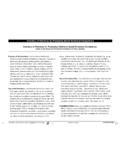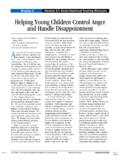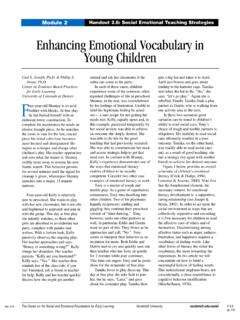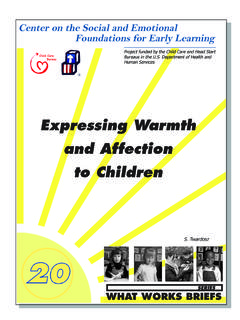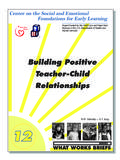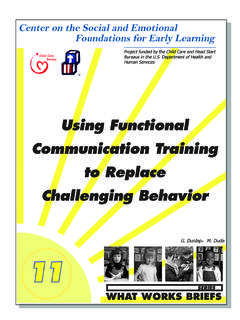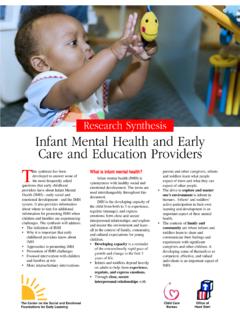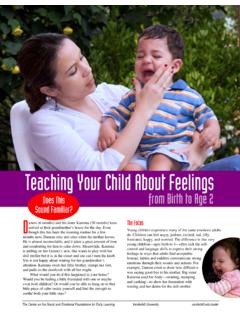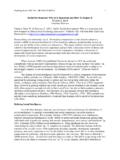Transcription of Fathers and Father-Figures: Their Important Role in ...
1 Center on the social and Emotional Foundations for Early Learning Project funded by the Child Care and Head Start Bureaus in the Department of Health and Human Services Fathers and father -Figures: Their Important Role in Children's social and Emotional development A. Quesenberry Ostrosky Corso SERIES. WHAT WORKS BRIEFS. Fathers and father -Figures: Their Important Role in Children's social and Emotional development This What Works Brief is part of a continuing series others who conduct staff development activities of short, easy-to-read, how to information packets should find them especially useful in sharing on a variety of evidence-based practices, strategies, information with professionals and parents. and intervention procedures. The Briefs are The Briefs include examples and vignettes that designed to be used to help teachers and other illustrate how practical strategies might be used in a caregivers support young children's social and variety of early childhood settings and home emotional development .
2 In-service providers and environments. Lenny Ramano is a first-time father of an extremely energetic 4-year-old son, Angelo Michael. Lenny's own father was not very involved in his life, particularly his school life, because Mr. Ramano worked long hours and his job necessitated that he travel often. Angelo Michael attends a Head Start program in the morning and a community child care program each afternoon. He loves going to school and talks about his teachers and friends frequently. He typically brings home artwork and books from the early childhood program, and at dinner, he shares stories of field trips and activities that occur at school. Lenny wants to become more involved in his son's early childhood programs. He has tried on several occasions to talk with the teachers about volunteering on field trips, reading books to the class, or sharing his expertise as a chef with the class, but t the teachers have not taken him up on his offers . He feels as if the teachers mostly share concerns and children's accomplishments with the mothers and do not really want parents to be very involved, especially Fathers .
3 For example, when the class was planning a field trip to the local planetarium, Lenny asked about coming along to help out. He was politely thanked for volunteering but told that there were plenty of adults for the number of children. Another time, he stayed a bit longer in the classroom when he dropped his son off, because Angelo Michael was rather clingy and did not want his father to leave. After about 10 minutes, a teacher moved close to where Lenny was sitting (just outside the circle for group time) and told him that she would take over now. He felt as if the teacher was suggesting that it was time for him to leave. Although Lenny realizes that he may be misreading things that the teachers say and do, he feels frustrated with not being able to get more involved. His wife, on the other hand, feels very welcome in the program and tells Lenny that she has no trouble talking with the teachers. The teachers, on hte other hand, believed that they were being welcoming to the father by acknowleding his offers yet respecting his time and work schedules.
4 The Changing Role of Fathers participation. Care must be taken to determine the unique Over the past 50 years, the role of Fathers and father -figures has strengths, wishes, and concerns of each parent as early care changed dramatically. Early research centered on the role that providers strive to bridge the gap between early childhood settings Fathers played in Their children's gender identity and children's and home. development . During the 1970s and 1980s, father involvement was often based on a deficit model, focusing on families without Fathers Fathers ' Impact on Children's social and present and the impact that father absence had on children's Emotional development development . In recent years, the focus has shifted to a strengths- There are several ways to conceptualize Fathers ' impact on based approach, looking at the positive impact of father involve- children. This Brief provides one way that emphasizes three areas ment and contibutionto the the day-to-day care of young children.
5 To consider when thinking about father involvement. These three Along with interest in the changing role of Fathers , a change in the areas are discussed below. Some variations in programs and definition of father also has emerged. Now the term father is outcomes exist because of differences in the cultural, demographic, sometimes used more broadly to describe men who are Important and socioeconomic backgrounds of the populations presented in in the life of a child. This broader definition is in no way meant to the research. undermine the importance of the role of the biological father in the life of a child. Instead, it serves to highlight the positive impact that Engagement and Interaction men ( , grandfathers, uncles, and stepfathers) can have on young Many factors affect the level of engagement and interaction children. What has remained constant over time is the acknowledg- between a father and his child. Naturally, all Fathers , like mothers, ment that parents, both mothers and Fathers , are children's first and have Their own way of interacting with and nurturing Their child.
6 Primary teachers. Every parent has a unique way of caring for and Although play makes up the largest paternal engagement activity, interacting with his or her child, with mothers and Fathers typically providing basic care activities, such as bathing and feeding Their interacting with Their children in different ways. Although some child, comes in a close second. Over the past several decades, Fathers , like Lenny in the example above, wish to become actively researchers have shown that levels of father engagement have involved in Their child's school life, other Fathers might not be as significantly increased. Evidence shows that the quality of comfortable in this role. One can imagine a continuum of Fathers interactions in a father -child relationship positively impacts the from those who do not choose to be involved in Their child's early cognitive, social , and moral development of young children. For care and education, to Fathers like Lenny who desire to be more example, when a child experiences positive interactions through involved, to other Fathers who are satisfied with Their level of play, reading a story, or singing a song, the bond between father and child increases.
7 Also, a father 's attitudes toward his child, his child's development , and the quality of these interactions are overly shy child is cautious when bringing the child into new crucial to the overall development of positive social and emotional situations or introducing the child to new people. Thus, the skills. Notably, the quality of father -child relationships also can father adapts his behavior to support his child's temperament. impact the relationships that children have with peers. social Early care providers should realize that a father 's willingness competence can be predicted to some extent by the quality of and comfort when caring for his child on a day-to-day basis can emotions shown between a father and his child during play. Lenny depend in part on the level of encouragement that he receives is a very social , outgoing father who frequently takes Angelo from his spouse, as well as from other relatives, medical Michael to events in the community.
8 Like his father , Angelo personnel, and the child's teachers. Therefore, it is Important to Michael is extremely social . He loves to play with peers and often support and encourage Fathers like Lenny who are eager to try can be found in the middle of a large group of playmates. to take an active role in Their child's education. Availability and Accessibility In the recent past, a great number of local efforts have been Availability and accessibility refer to both physical and emotional undertaken to support Fathers ' accessibility, engagement, and presence. One can imagine a time when a young child enters the interaction with Their children. For example, some programs kitchen where her dad is busy cooking something and the child is host father nights, playgroups, and support groups. Since these told to find something to do and not bother the adult, or a time programs are relatively new, little is known about how they are when a young child attempts to tell her parent a story but Dad is structured and what impact they have on Fathers ' behaviors.
9 For really not there as he watches his favorite television program those developing and implementing programs that support instead. father involvement, there is a significant need for systematic The amount of time that Fathers are accessible and the time that evaluation efforts to determine what outcomes are being they actually spend with Their child can be highly dependent on achieved. factors such as work schedules and variations in child routines. Programs need to be clear about why they are concerned about Recently, levels of availability and accessibility have increased as reaching out to Fathers and increasing father involvement. They Fathers are becoming more and more involved in the lives of Their need to emphasize the unique contribution each parent makes to children. Fathers may have to be more creative when trying to find his or her child, that is, what Fathers do is sometimes different ways to spend time with Their child outside of the home.
10 For from what mothers do, and both are Important . In addition, as example, in our vignette, Lenny is willing to volunteer and help out fatherhood programs are created, it is critical that they be at school so that he is able to spend more time with Angelo developed within a clear framework that has the potential to Michael. explain or predict the impact of the program. To develop this framework, early care staff should first assess the needs of the Day-to-Day Care Fathers they serve. Early in the year, ask Fathers what the Now more than ever, Fathers are taking an active role in the day-to- program can do to help, either talking individually with Fathers day care of Their children. This is an excellent time for social and or at a parent meeting. Staff should also ask if Fathers are emotional skills to be developed. Fathers ' responsibility for day-to- satisfied with the range of involvement options available in the day care can be measured in two ways.
